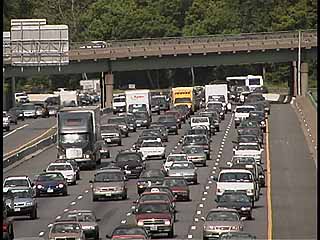June 5, 2006
Caught In Traffic
By Michael D. Shaw
No one likes to be crawling along in a moving parking lot, but some authorities would have you quietly rejoice about traffic congestion. After all, they argue, it is not so much a problem. Rather, it is a reflection of economic success. If you don’t want traffic, they might say, go live in the middle of nowhere—far from at least the conventional sources of employment.
Simply put, traffic congestion occurs because most people want to live in low density neighborhoods, that are not usually well served by public transit, but must commute to other areas; economic efficiency dictates that most people have to perform many of life’s daily functions at approximately the same time that others do; and many people prefer the comfort of their private vehicles over public transit.
Complicating efforts to alleviate heavy traffic is an interesting phenomenon known variously as “induced traffic” or in more elite circles, the principle of triple convergence. Here’s how it works:
Consider a heavily congested freeway, such as the 101 and 405 in Los Angeles, or the Beltway in the Washington, DC metro area.
Suppose, as if by magic, we were to quadruple the capacity of these arteries. What would happen? At first, traffic would flow beautifully. But before too long, the word would get out. Some commuters who had eschewed these routes during the peak hours, would now revert to peak hour commuting. Some who had taken alternate routes would shift back to these roads. And, some who had previously used public transit would get back into their cars, on these same freeways.
Unfortunately, this principle also applies to virtually any other attempt to ease traffic.
If public transit is greatly expanded, as it was recently in Portland, Oregon and Dallas, Texas, for example, congestion will decline for awhile, but the newly freed-up roads will gradually get more popular again. Believe it or not, the principle even applies to staggered work hours and telecommuting, at least at the relatively low levels that these work modalities have been tried so far.
The trick seems to be to develop solutions that will cause such a great reduction in traffic that they will be able to overcome the “backlash” effect of induced traffic. I believe that telecommuting can achieve this. No one would disagree that at present, millions of workers commute to an office and then log on to a server, that could be accessed from anywhere, including their homes.
In this case, technology and implementation are tiny issues compared to our breaking free of old-fashioned workplace paradigms, coupled with dubious notions of management control that can only be exercised in an up close and personal manner.
If telecommuting offers some promise for the “supply” side of the congestion issue, the “demand” side might finally be curtailed with the return to the central city, favored by a growing number of yuppies and empty nesters, alike. No doubt, $3.00 per gallon gasoline has energized this trend. Many are quite willing to give up the quiet and seclusion of the lower density suburbs for the convenience and peace of mind of a life far less dependent on the automobile.
As it happens, traffic congestion is far from unknown in the ‘burbs, as anyone who visits a suburban mall will tell you.
So, what’s the answer?
Unlike many environmental issues, the answer to congestion is ultimately a personal choice. Many of us can choose to commute at off-peak hours. One common practice is to make the inbound trip very early in the morning, and get in a nice healthy workout before arriving at the office. Some of us could surely make the step to moving back into town, and a goodly number of us could probably convince management to allow us some amount of telecommuting.
More than that, we could probably eat lunch other than between 12:00 and 1:00, and run errands other than on weekends.
All of these things will force us to change some habits, but it’s either that or endless complaining. Think about it!
